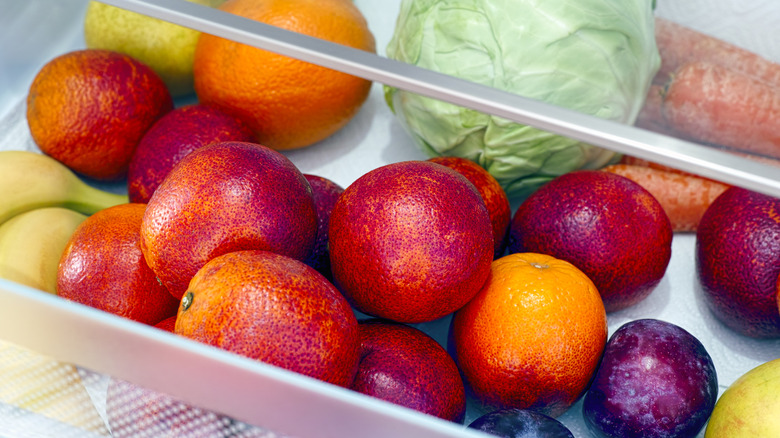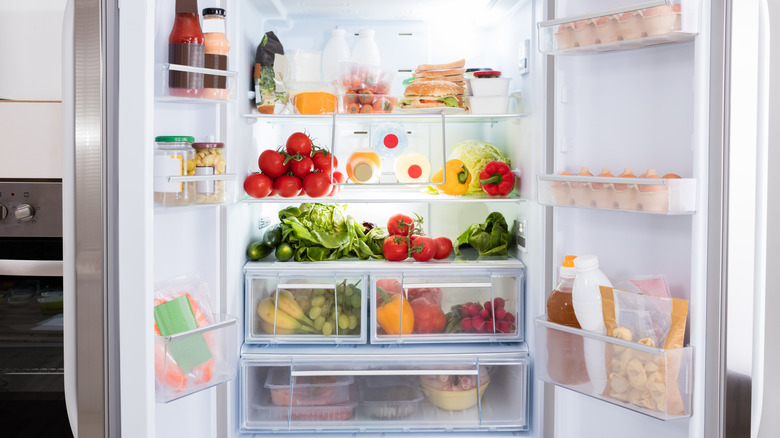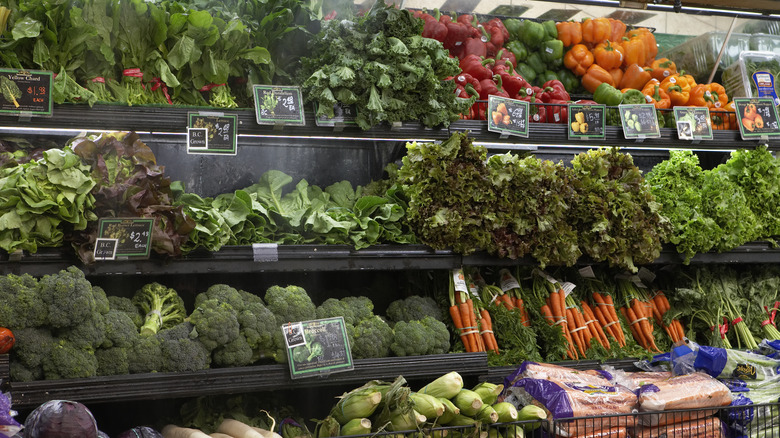How To Customize Crisper Drawer Settings To Get The Most Out Of Produce
Fresh produce, especially lettuce, is so full of promise at the grocery store. Piled high and regularly misted to keep them looking succulent, fresh heads of greens are irresistible. But once you get that head of romaine or red leaf home, the clock is ticking; you've got to act fast, because that lettuce was already going bad when you bought it. You have anywhere from seven to 10 days before your fresh greens start to go brown and wilty. Thankfully, you have the perfect spot in your fridge to keep your lettuce, fruits, and other veggies looking their best: the crisper drawer.
Almost every model of kitchen-sized refrigerators has some type of crisper drawer, which might also be known as the vegetable drawer, humidity drawer, or simply "the crisper." Lots of people don't know that there are different settings for the crisper and use those bottom-shelf compartments like empty dresser drawers. But the crisper wasn't made for meat, beer, or many of the other items that get tossed in.
This handy drawer is designed to let you control the humidity and airflow inside the drawer, which, in turn, keeps vegetables fresher longer. If you find yourself tossing more produce than you eat, don't resign yourself to wasting food, especially in a time of record-high inflation. Learn how to use your crisper drawers properly, and you'll get significantly more time before your lettuce goes limp.
How to adjust the crisper's humidity
If you've never considered the settings of your crisper drawer, open the fridge door and take a look (usually, the settings are on the handle or somewhere nearby). Depending on what you're trying to store, you can set them to either high or low humidity.
The high-humidity setting shuts off the airflow into the drawer, allowing the humidity from the produce to collect. This will also keep the drawer slightly warmer than the rest of the fridge. The low-humidity setting lets the air circulating throughout the refrigerator flow into the drawer, keeping the temperature cooler and blowing out all of the humidity.
If you're not sure if the drawer should be kept at high humidity or low humidity, don't worry. There are usually two crisper drawers, so you can set one low and one high. Some fruits and vegetables stay fresher longer in high humidity, including lettuce, asparagus, summer squash, and kale. They're thin-skinned and prone to wilting. You can also store anything in the high-humidity drawer that is sensitive to ethylene, such as asparagus, broccoli, cauliflower, cucumbers, strawberries, and fresh herbs. (Ethylene is the gas released as fruits and veggies ripen.)
Store thicker-skinned produce, which tends to rot faster, in the low-humidity drawer. This includes apples, stone fruit, and honeydew. Most of these items tend to emit a lot of ethylene, which makes them ripen faster. The extra airflow blows that away and keeps the produce fresher longer.
Unpacking your produce properly
Once you have your crispers all set up, make sure that in addition to dividing the cukes from the mangos, you pack the drawer properly. Just like the rest of your refrigerator, air needs to be able to flow all around the inside of the drawer to keep the conditions stable. Don't stuff the drawers full; you'll be defeating the purpose of the humidity settings, not to mention possibly crushing some of the softer stuff, including berries and bags of greens. Keep your drawers about two-thirds full, which should give you enough fresh veggies and fruits for the week.
You can also try lining your crisper drawers with paper towels to squeeze a little extra time out of your produce. The towels will absorb any excess moisture from your supermarket harvest and help maintain the humidity settings of the drawers. Plus, it'll keep the insides of your drawers nice and clean. (Just remember to swap out the paper towels whenever you add a fresh batch of produce to the drawers.)
With a little forethought and a couple of paper towels, you can save money on wasted groceries and cut down on food waste, too.


